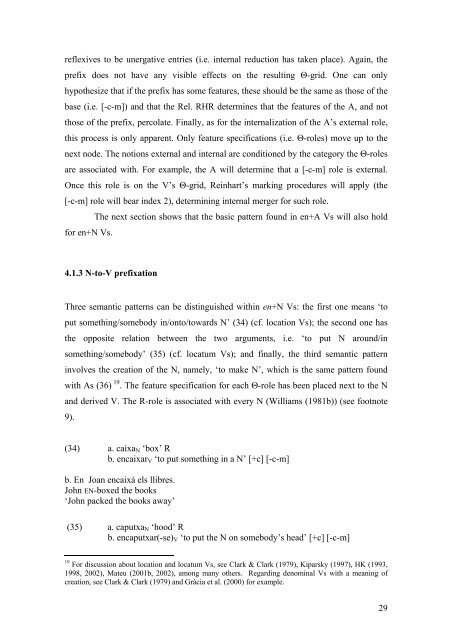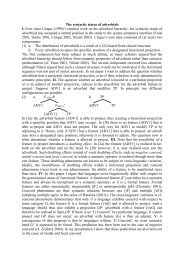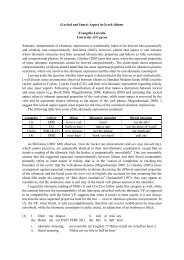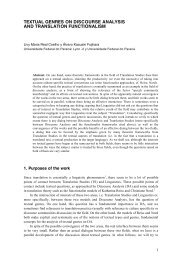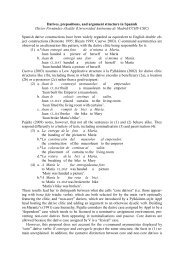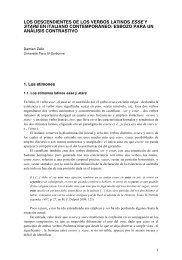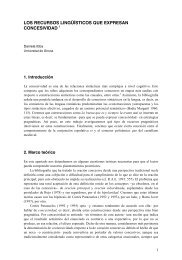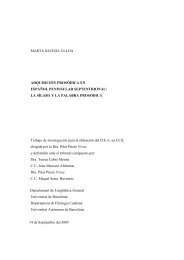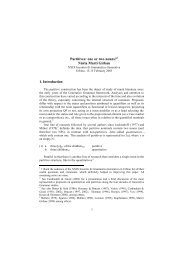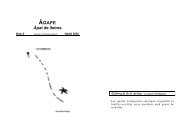Prefixation in English and Catalan - Departament de Filologia ...
Prefixation in English and Catalan - Departament de Filologia ...
Prefixation in English and Catalan - Departament de Filologia ...
Create successful ePaper yourself
Turn your PDF publications into a flip-book with our unique Google optimized e-Paper software.
eflexives to be unergative entries (i.e. <strong>in</strong>ternal reduction has taken place). Aga<strong>in</strong>, the<br />
prefix does not have any visible effects on the result<strong>in</strong>g Θ-grid. One can only<br />
hypothesize that if the prefix has some features, these should be the same as those of the<br />
base (i.e. [-c-m]) <strong>and</strong> that the Rel. RHR <strong>de</strong>term<strong>in</strong>es that the features of the A, <strong>and</strong> not<br />
those of the prefix, percolate. F<strong>in</strong>ally, as for the <strong>in</strong>ternalization of the A’s external role,<br />
this process is only apparent. Only feature specifications (i.e. Θ-roles) move up to the<br />
next no<strong>de</strong>. The notions external <strong>and</strong> <strong>in</strong>ternal are conditioned by the category the Θ-roles<br />
are associated with. For example, the A will <strong>de</strong>term<strong>in</strong>e that a [-c-m] role is external.<br />
Once this role is on the V’s Θ-grid, Re<strong>in</strong>hart’s mark<strong>in</strong>g procedures will apply (the<br />
[-c-m] role will bear <strong>in</strong><strong>de</strong>x 2), <strong>de</strong>term<strong>in</strong><strong>in</strong>g <strong>in</strong>ternal merger for such role.<br />
The next section shows that the basic pattern found <strong>in</strong> en+A Vs will also hold<br />
for en+N Vs.<br />
4.1.3 N-to-V prefixation<br />
Three semantic patterns can be dist<strong>in</strong>guished with<strong>in</strong> en+N Vs: the first one means ‘to<br />
put someth<strong>in</strong>g/somebody <strong>in</strong>/onto/towards N’ (34) (cf. location Vs); the second one has<br />
the opposite relation between the two arguments, i.e. ‘to put N around/<strong>in</strong><br />
someth<strong>in</strong>g/somebody’ (35) (cf. locatum Vs); <strong>and</strong> f<strong>in</strong>ally, the third semantic pattern<br />
<strong>in</strong>volves the creation of the N, namely, ‘to make N’, which is the same pattern found<br />
with As (36) 19 . The feature specification for each Θ-role has been placed next to the N<br />
<strong>and</strong> <strong>de</strong>rived V. The R-role is associated with every N (Williams (1981b)) (see footnote<br />
9).<br />
(34) a. caixaN ‘box’ R<br />
b. encaixarV ‘to put someth<strong>in</strong>g <strong>in</strong> a N’ [+c] [-c-m]<br />
b. En Joan encaixà els llibres.<br />
John EN-boxed the books<br />
‘John packed the books away’<br />
(35) a. caputxaN ‘hood’ R<br />
b. encaputxar(-se)V ‘to put the N on somebody’s head’ [+c] [-c-m]<br />
19 For discussion about location <strong>and</strong> locatum Vs, see Clark & Clark (1979), Kiparsky (1997), HK (1993,<br />
1998, 2002), Mateu (2001b, 2002), among many others. Regard<strong>in</strong>g <strong>de</strong>nom<strong>in</strong>al Vs with a mean<strong>in</strong>g of<br />
creation, see Clark & Clark (1979) <strong>and</strong> Gràcia et al. (2000) for example.<br />
29


